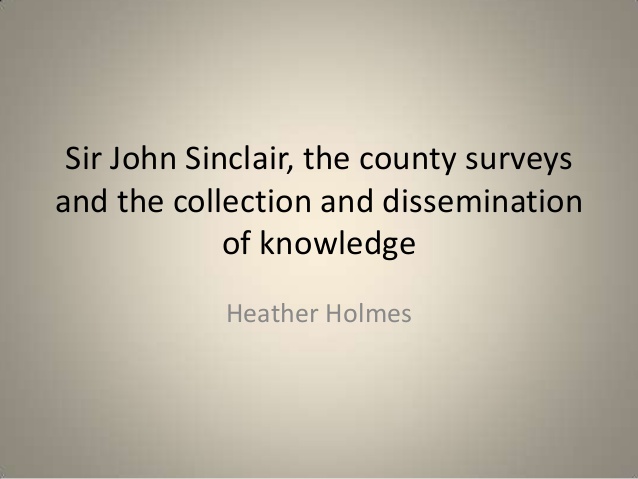Those familiar with the Statistical Accounts of Scotland will be aware that they belong to a greater body of works initiated and supervised by Sir John Sinclair, forming the base of what he envisaged as a grand ‘pyramid of agricultural enquiries’. An extensive and ambitious survey of ‘the existing agricultural state of England and Scotland respectively, and the means by which each might be improved’, the pyramid comprised four levels. Scotland’s parishes were the focus of the Statistical Accounts, while the ‘General View…’ series covered a much broader geographical area by focusing on the counties of Scotland, England and Wales. Then came The General Report of the Agricultural State, and Political Circumstances of Scotland, published in 5 volumes in 1814 and, at the pinnacle of the pyramid, Sinclair’s Code of Agriculture, published in one volume in 1817. This, as historian Heather Holmes explains, “combined all the enquiries into one code ‘for the purpose of rendering, a general knowledge of the principles of husbandry, more easily accessible’.”
The Statistical Accounts of Scotland service makes the full text of the accounts available through searchable digitised copies which provide important reference sources for researchers across numerous disciplines and fields of study. Over the years, we have also built up a fantastic collection of related resources including maps and illustrations, correspondence, manuscripts and information about Sinclair’s other works.
We are therefore delighted to report that EDINA is currently undertaking a project to assess the potential of a similar virtual collection of the County Surveys, the second layer of Sinclair’s pyramid.
The County Surveys recorded comprehensive information on the agriculture, rural economy and political economy of each county in Great Britain between 1793 and 1817. They provide a unique insight into the innovation and agricultural improvement during a significant period in the making of Britain as the first industrial nation. Despite its remarkable historical interest, this resource is currently under-used because very few surveys are available in digital format, and printed copies are difficult to locate and access.
‘The County Surveys 1793 – 1817: Exploring Considered Digitisation’ aims to explore how the creation of a virtual collection can unleash the potential of the County Surveys for discovery. The project is funded by EDINA, University of Edinburgh and scheduled for completion in July 2015.
Our approach of “considered digitisation” involves:
- Reviewing extant digital fragments of the County Surveys to assess their availability for public access, the quality of their digital image, OCR text and metadata, and their suitability for computer automated text analysis, search and retrieval
- Supporting re-digitisation when appropriate to offer public domain content of sufficient quality
- Identifying sources of printed copies for the County Survey and encouraging digitisation
- Engaging with organisations holding copies of the County Surveys to encourage and support digitisation and re-digitisation efforts, and sharing openly our experience of “considered digitisation”.
Find out more about the project and its progress here.

